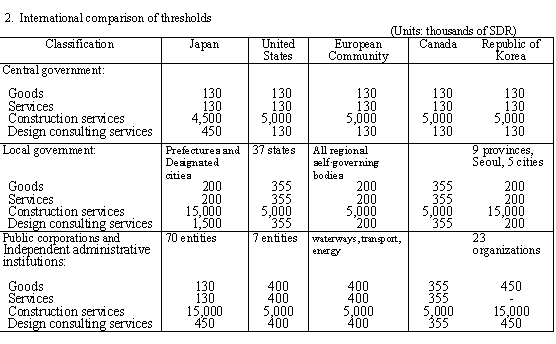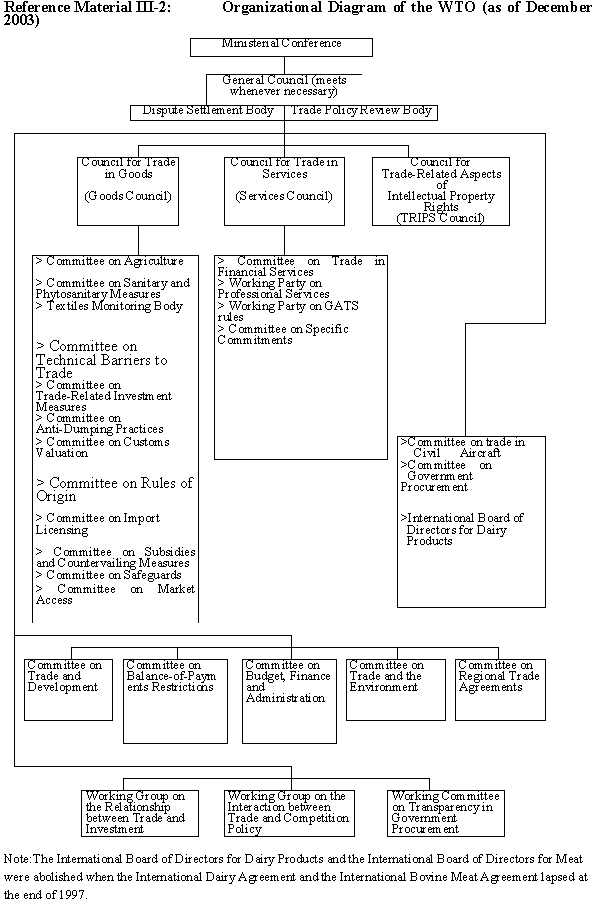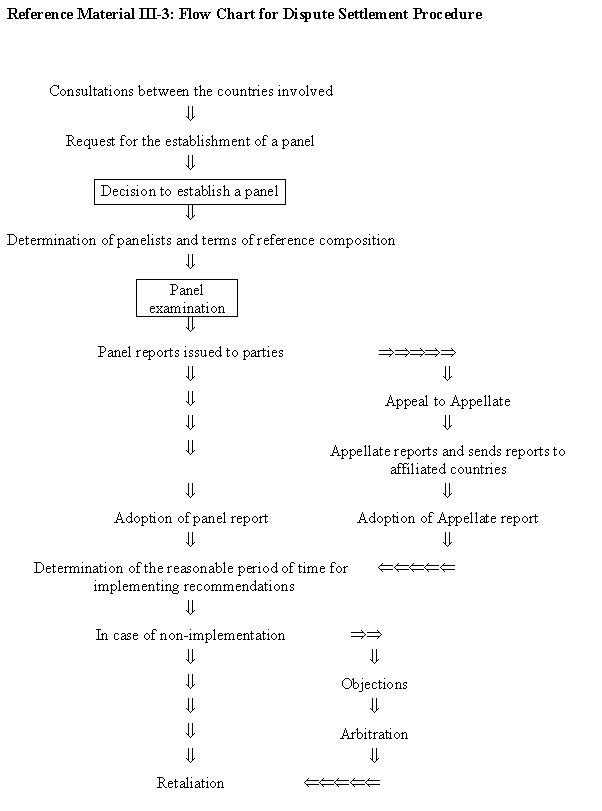
(1) Government Procurement Seminar
The Ministry of Foreign Affairs holds a seminar on government procurement each year, based on the Action Program on Government Procurement adopted at the 20th Meeting of the Action Program Committee in February 1994 and on the Procedures for Government Procurement on Products (Operational Guidelines) adopted at the 21st Meeting of the Action Program Committee held in March 1994. In 2003, the seminar was held on 25 April (with 84 domestic and 20 foreign suppliers participating).
The above two voluntary measures also call for the other ministries and agencies to hold seminars on government procurement as necessary. In 2003, the following seminars were held.
Table III-1 Government Procurement Seminars in Japanese Ministries and Agencies in 2003
| Procurement Organization | Date | Content |
| National Public Safety Commission (National Police Agency) | 16 May 2003 | Government Procurement Seminar, Government Procurement Annual Meeting (Telecommunications) |
| Defense Agency | 23 May 2003 | Government Procurement Seminar, Government Procurement Annual Meeting (Medical Technology) |
| Ministry of Public Management, Home Affairs, Posts and Telecommunications | 28 May 2003 | Government Procurement Seminar, Government Procurement Annual Meeting (Telecommunications, Medical Technology) |
| Ministry of Health, labour, and Welfare | 20 May 2003 | Government Procurement Seminar, Government Procurement Annual Meeting (Medical Technology) |
| Ministry of Education, Culture, Sports, Science and Technology | 20 May 2003 | Government Procurement Seminar, Government Procurement Annual Meeting (Telecommunications, Medical Technology) |
| Ministry of Land, Infrastructure, and Transport | 20 May 2003 | Government Procurement Seminar, Government Procurement Annual Meeting (Telecommunications) |
(2) Voluntary Review Meeting
In 2003, by means of questionnaire survey, the opinions of suppliers were solicited concerning implementation and utilization of voluntary measures. In addition, a voluntary review, a follow-up to the voluntary measures based on statistics, etc., was held on 6 November and gave consideration to the results of the survey (Reference Materials III-4). The Voluntary Review Meeting drew up the Government Initiative on Future Management of Government Procurement (Reference Materials III-5) based upon the reviews above.
From 2001, among the opinions and requests gathered by the questionnaire survey, the government picked up those (1) from many respondents, (2) considered important to improve the current measures, and (3) considered necessary information to the public, and release their answers to them on the website of the prime minister: https://www.kantei.go.jp/ (Reference Material III-6).
(3) Action Program Committee
In the 35th Action Program Committee held on 27 November 2003, the state of the implementation of the voluntary measures reviewed at the voluntary review meeting was confirmed, and the Government Initiative on Future Management of Government Procurement drawn by the voluntary review committee was approved.
(4) Thresholds
Thresholds, which vary according to types of contract specified in the WTO Agreement on Government Procurement, are obtained by converting the applied standard values (in SDR) into the national currency (The Standard Values are revised every two fiscal years.).
The thresholds in the voluntary measures related to government procurement as formulated by the Action Program Committee are revised according to these notifications. The current thresholds applicable are in Reference Material III-7.
Reference Material III-1:
World Trade Organization Agreement on Government Procurement
| The Marrakesh Agreement Establishing the World Trade Organization (WTO Founding Agreement) |
| Attached Document I |
| Attached Document IA: Multilateral Agreements on Trade in Goods |
| (1) | General Agreement on Tariffs and Trade 1994 (GATT 1994) |
| (2) | Agreement on Agriculture |
| (3) | Agreement on the Application of Sanitary and Phytosanitary Measures |
| (4) | Agreement on Textiles and Clothing (ATC) |
| (5) | Agreement on Technical Barriers to Trade (Standard Agreement) |
| (6) | Agreement on Trade-Related Investment Measures |
| (7) | Agreement on Implementation of Article VI of the General Agreement on Tariffs and Trade 1994 (Anti-Dumping Agreement) |
| (8) | Agreement on Implementation of Article VII of the General Agreement on Tariffs and Trade 1994 (Customs Valuation Agreement) |
| (9) | Agreement on Preshipment Inspection |
| (10) | Agreement on Rules of Origin |
| (11) | Agreement on Import Licensing Procedures |
| (12) | Agreement on Subsidies and Countervailing Measures |
| (13) | Agreement on Safeguards |
| Attached Document IB: General Agreement on Trade in Services |
| Attached Document IC: Agreement on Trade-Related Aspects of Intellectual Property Rights |
| Attached Document II: Understanding on Rules and Procedures Governing the Settlement of Disputes |
| Attached Document III: Trade Policy Review Mechanism |
| Attached Document IV: Plurilateral Trade Agreements |
| (1) | Agreement on Trade in Civil Aircraft |
| (2) | Agreement on Government Procurement |
| (3) | International Dairy Agreement (lapsed at the end of 1997) |
| (4) | International Bovine Meat Agreement (lapsed at the end of 1997) |


Reference Material III-4: Results of the Inquiries to Suppliers (2003)
| Questionnaire Items | Ratio (%) |
| In all fields | |
| Use of the information on government procurements offered at the beginning of each fiscal year: | |
| a) Frequently | 46.4 |
| b) Occasionally | 39.3 |
| c) Never | 14.3 |
| Usefulness of individual pieces of information on government procurements | |
| a) Good | 25.5 |
| b) Fair | 63.6 |
| c) Unsatisfactory | 10.9 |
| Annual Report ("Japan's Government Procurement: Policy and Achievements") | |
| a) Satisfied | 17.9 |
| b) Generally satisfied | 62.5 |
| c) Not satisfied | 3.6 |
| d) Never using of it | 16.1 |
| Securing competitiveness and transparency through the reduction of single tendering and selective tendering | |
| a) Well secured. | 20.0 |
| b) Secured, but not sufficiently. | 72.7 |
| c) Not secured. | 7.3 |
| Implementation status of the overall-greatest-value evaluation method | |
| a) The method has well promoted reasonable assessments | 15.4 |
| b) The method has promoted reasonable assessments to a certain extent | 71.2 |
| c) The method has not worked well | 13.5 |
| Complaint review system | |
| a) Considered using the system. | 9.0 |
| b) Never considered using the system. | 62.5 |
| c) Did not know the system | 28.6 |
| In telecommunication and medical technology fields | |
| Evaluation method in the Standard Guide to the Overall-greatest-value methodology | |
| a) Reasonable | 15.6 |
| b) Reasonable in many cases | 84.4 |
| c) Not reasonable | 0.0 |
| Evaluation method in the Standard Guide to the Government Procurement of Information Systems | |
| a) Reasonable | 14.7 |
| b) Reasonable in many cases | 76.5 |
| c) Not reasonable | 8.8 |
| Threshold for overall-greatest value evaluation method (385,000 SDRs) | |
| a) Reasonable | 86.1 |
| b) Needs to be reduced | 8.3 |
| c) Needs to be raised | 5.6 |
* Fifty respondents answered to the questionnaire.
* Due to rounding of figures, the totals do not add up to 100% in some cases.
Reference Material III|5
Reference Material III - 6
The Japanese government has listened to suppliers' opinions and requests about our voluntary measures on government procurement by conducting a questionnaire survey every year. On this website, among the opinions and requests gathered by the survey in 2001 and 2002, we pick up those (1) from many respondents, (2) considered important to improve the current measures, and (3) considered necessary information to the public, and release our answers to them.
|
We welcome the fact that the unification of the license to tender between the central government agencies has reduced our labor for bidding. However, because of the unification, in some cases, for example, computer system procurement, we were not allowed to tender for it even though we used to bid for similar-scale procurement. We would like the government to revise the current graduated licensing system. |
Answer from the Government
The government is aware of the request aforementioned. At the Inter-Ministerial Council for Government Procurement on Information System, Cabinet Office and ministries agreed on "Towards Improvement of Government Procurement of Information Systems" in March 2002 (revised in April 2002 and March 2003). This agreement includes flexible application of the licensing system considering technical criteria such as suppliers' line up of advanced IT engineers or contract records in private procurement. It also authorizes collective enterprises, e.g., a joint venture, to get the license to tender. Through these measures, the government intends to expand opportunities of participation in procurement for technically competitive suppliers, regardless of their business scale.
|
To make appropriate tenders for requests of buyers, it is very important for suppliers, such as suppliers of computer systems, to get information about procurement before the public notice for it. We would like the government to promptly provide the information of extra procurement plans, for example, ones added by a supplementary budget. |
Answer from the Government
Based on such requests aforementioned, the government has striven for quicker release of procurement information. In fact, at the contact points of the central government, we release information as much as possible, for example, by providing the latest list of procurement plans for public reading before release in the official gazette. On the other hand, we provide information carefully, considering that uncertain information might disadvantage suppliers in their business.
If you are interested in getting more information at an earlier stage, please feel free to get in touch with each contact point. (The list of contact points is available at https://japan.kantei.go.jp/procurement/2002/contact.html.)
|
We are afraid that the current Overall- Greatest-Value Evaluation method thinks little of technical points, while it attaches too much importance to price. As a result, the method has still allowed suppliers who offer an extremely low price to make a successful bid in many cases even under the Overall- Greatest-Value Evaluation. We would like you to improve the current method. |
Answer from the Government
The government is aware of the opinion aforementioned. At the Inter-Ministerial Council for Government Procurement on Information System, Cabinet Office and ministries agreed on "Towards Improvement of Government Procurement of Information Systems" on March 2002 (revised on April 2002 and March 2003). This agreement introduces a tender evaluation of adding up technical and pricing points, calculated on a tender price, when an information system for e-Government project is procured on Overall-Greatest-Value Evaluation method and the system cannot be developed by utilizing existing software. To procure high-quality information systems more reasonably, this new evaluation that rates maximum total points as best has entered into force on August 1st, 2002.
|
In the sector of telecommunication and medical technology products, procurement cases under the threshold for Overall- Greatest-Value Evaluation: 385,000 SDR
(equals to \ 54 mil. Yen in 2003) have been increasing, for example, by technological innovation. We would like you to think about lowering this threshold.
|
Answer from the Government
The threshold for Overall- Greatest-Value Evaluation in the telecommunication and medical technology product sector has already been lowered step by step from 800,000 to 600,000 SDR in April 1996, from 600,000 to 400,000 SDR in April 1997, and from 400,000 to 385,000 SDR in April 1998.
The government would consider lowering the threshold again if the market price of many procurement goods declines so as to influence suppliers' business activities. However, according to the "Survey on Government Procurement under the Action Program (2003)" on suppliers, more than 80% of respondents still recognize that the present threshold should be kept. Based on this result, at present we conclude that it is not necessary to further lower the threshold.
|
We did not file a complaint because we were afraid that it might bring about business disadvantage in the future. The procedure for filing seems troublesome, and it also makes us hesitate to file a complaint. |
Answer from the Government
To discriminatingly treat suppliers who made use of the Complaint Review System violates the Agreement on Government Procurement, of which Japan is a member state. Therefore, the government has diligently informed procurement entities about the Agreement and instructed them to observe it. We have also made an effort to provide information that is as easy to understand as possible. For example, on the Cabinet Office Homepage (http://www5.cao.go.jp/access/english/chans_main_e.html), we present the relevant regulations and the Review Board's reports on past complaints. In addition, your agent, e.g. lawyer, can take procedures for you in this system. If you have any other questions about the system, feel free to contact the Office for Government Procurement Challenge System at the Cabinet Office
(Tel: 03-3581-0262).
| We are considering the possibility of using the Complaint System. Can we file a complaint about the specifications in procurement through this Complaint System? |
Answer from the Government
Any supplier may file a complaint at any stage of the procurement procedures, when it believes the procurement has been carried out in a manner inconsistent with any provisions of the procedures laid out in the rules such as the Agreement on Government Procurement. Therefore, it can file a complaint about specifications for procurement, which are considered to be in violation of the rules, such as the Agreement on Government Procurement.
In such a case, the supplier is recommended to first confer with the procuring entity and to reach a settlement. If you have any other questions about the system, feel free to contact the Office for Government Procurement Challenge System at the Cabinet Office
(Tel: 03-3581-0262).
|
We insist that the government should introduce the minimum award price rule as a countermeasure against the recent controversial ultra-low-price bid. |
|
It is said that an enquiry for abnormally low tenders is carried out for ultra-low-price bids. How is this enquiry implemented concerning Government procurement of Information Systems? Are criteria or results of enquiries announced publicly? |
Answer from the Government
At the Inter-Ministerial Council for Government Procurement on Information System, the Cabinet Office and ministries agreed on "Towards Improvement of Government Procurement of Information Systems" in March 2002 (revised in April 2002 and March 2003). This agreement stipulates that we can avoid contracting with a supplier who is considered to have problems securing implementation of contracts or fair trading based on the enquiry of validity of bid price and bidder performance. The summary results of the enquiry for abnormally low tenders may be announced publicly.
|
The procurement of information systems, such as computers, necessitates administrative and maintenance expenses or renewal fees as well as initial equipment. Should these procurement costs be evaluated based on life-cycle cost with clear definition and criteria? |
Answer from the Government
The government is aware of the request aforementioned. At the Inter-Ministerial Council for Government Procurement on Information System, the Cabinet Office and ministries agreed on "Towards Improvement of Government Procurement of Information Systems" in March 2002 (revised in April 2002 and March 2003). This agreement stipulates that, in principle, a multiple-year contract is carried out using a contract resulting in treasury obligation, when procuring entities need to continuously contract with the supplier to whom the contract was initially awarded in such cases as large scale continuous development, administrative and maintenance service, or consultant service. Otherwise, open tendering is adopted under the evaluation of life-cycle cost price for estimated total procurement in all processes such as planning, coordination, design, development, administration and maintenance.
Reference Material III-7
The standard values for all types of voluntary measures determined in the Committee for Drawing Up and Promoting the Action Program, based on Notification No. 31 of the Ministry of Finance as published in the official gazette (Kanpo) dated 23 January 2004, have been set as follows: (Applying to procurement contracts awarded between 1 April 2004 and 31 March 2006)
| SDR 500 | equivalent to 80,000 yen | |
| SDR 100,000 | equivalent to 16 million yen | |
| SDR 385,000 | equivalent to 62 million yen | |
| SDR 800,000 | equivalent to 130 million yen | |
| SDR 2 million | equivalent to 320 million yen | |
| SDR 5 million | equivalent to 800 million yen |
1. Thresholds
(1) Thresholds for the WTO Agreement on Government Procurement
| Classification | Central government | Local government | Public corporations and Independent administrative institutions |
| Products | 21 million yen (SDR 130,000) |
32 million yen (SDR 200,000) |
21 million yen (SDR 130,000) |
| Services | 21 million yen (SDR 130,000) |
32 million yen (SDR 200,000) |
21 million yen (SDR 130,000) |
| Construction services | 730 million yen (SDR 4.5 million) |
2.43 billion yen (SDR 15 million) |
2.43 billion yen (SDR 15 million) |
| Design consulting services |
73 million yen (SDR 450,000) |
240 million yen (SDR 1.5 million) |
73 million yen (SDR 450,000) |
(Note) The above values converted to Japanese currency are applicable from 1 April 2004 to 31 March 2006.
(2) Threshold for Voluntary Measures
In the voluntary measures or the Action Program on government procurement, the threshold for procurement of products and services (except procurement by local government), is lowered from SDR 130,000 (19 million yen) to SDR 100,000 (14 million yen).
(3) Threshold in the Japan Singapore Economic Agreement for a New Age Partnership
From November 30, 2002, in which the Agreement entered into force, the threshold for the procurement of goods and services by the central government, public corporations and independent administrative institutions became lowered to 100,000 SDR(14 mil. Yen).
